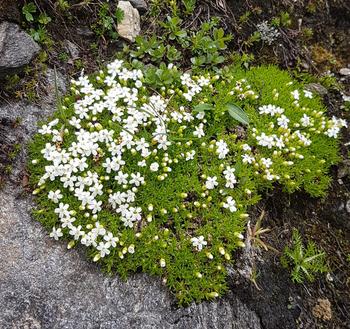* New Publication *
by Julien Roy and Julien B. Bachelier
Frontiers in Ecology and the Environment 2020, 18(3), 120; https://doi.org/10.1002/fee.2182
News from Apr 08, 2020
Distributed worldwide across arctic‐alpine ecosystems, the wildflower Silene acaulis is most notorious for forming remarkably large cushions that are essential for maintaining alpine biodiversity. Up to 3 m in diameter and living for up to three centuries in alpine meadows and fell‐fields, as well as on cliffs, these cushions comprise different subspecies usually found on distinct bedrocks. All typically have small pinkish to purple nectar‐producing flowers, which are pollinated by diverse insects.
In July 2018, we found a rare cushion of white flowers growing on shale near Grossglockner, a mountain in the Austrian Alps. It was the only white‐flowered individual we saw during that week, and did not appear to be a part of any larger population. White flowers of this species are seldom reported in the literature and never seem to form or dominate any populations.
Whether white flowers are due to a somatic mutation or deleterious gene association is still unknown, and their frequency, persistence, and evolutionary origin have never been studied. One possible explanation is that white flowers exclude the pollinators that disperse the necrotic fungus Microbotryum, which sometimes infects the anthers of S acaulis. The exclusion of regular pollinators by white flowers would provide an obvious fitness advantage to avoid contamination. So why do they remain so rare in S acaulis natural populations, and even in collections? Does the price of excluding pollinators outweigh the benefits? Are pollinators not affected or do white flowers attract new visitors? The evolutionary and functional significance of floral color in this emblematic alpine plant remains elusive but what a rare and beautiful addition to the rainbow of mountain flora.


